It has been so long since I’ve written a post about my work I have a lot of topics to write about. Before I move on to some of the things I’ve been doing more recently, though, I want to tie up some loose ends regarding the tide pool bowl.
If you look at the picture above you’ll notice that the outside of the bowl (reflected in the mirror) looks shinier than the inside. That is because the bowl was baked inside of a bowl-shaped glass form. As a result the surface on the outside is almost glassy, while the surface on the inside, which was sanded and buffed with a cloth is more satiny.
It is always hard for me to decide whether to buff the surface of my pieces to a glass-like shine with a buffing wheel or leave them with the satiny surface produced by hand buffing. On the one hand I prefer the feeling of the hand buffed surface, on the other I’ve found that a glassy surface reveals more of the details in a complex cane.
Because I was reluctant to try buffing the inside of the bowl with my buffing wheel I opted to leave it hand buffed. Then, I just happened to come across an advertisement for a cotton “mushroom buff” drill-attachment 3 inches in diameter. I had no idea they could be so large.
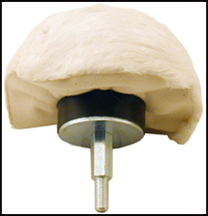
It looked like it would be a good fit for the curvature of the bowl so I decided to order one and try it. It was made of the same cotton fabric as my buffing wheel and it did fit nicely against the curvature of my bowl. Unfortunately, the mandrel was too large for my Dremel so I had to use a much larger (and heavier) power drill.

At first I held the bowl in one hand and the drill in the other but it was hard to control the drill because it was so heavy. Furthermore, my wrist tired quickly. So, instead of holding it I locked the handle in a vise on my workbench. This freed up both hands to hold and manipulate the bowl. In the picture above I am sitting behind the drill with my arms on either side of it. Below you can see the drill locked into the bench vise.

At first the buffer didn’t work very well; the cloth was too stiff and packed too tightly. I first loosened up the cloth by holding the spinning buff against the rough surface of a cement block. Then I used a wire brush to fray the edges of the cloth in the buff. After I did that the buff looked like this:
The surface became fluffy and much softer. This time the outcome was much better. I believe that with more practice I will get even better results, so this mushroom buff will become a permanent part of my toolbox. (These are available from many sources, just google “mushroom buff.”)
Some close-ups.



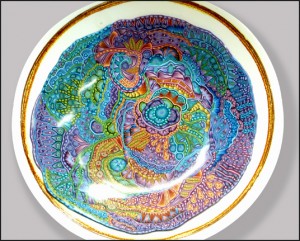
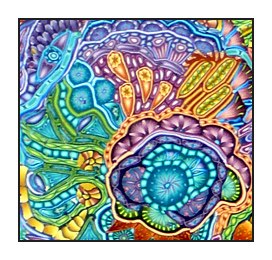

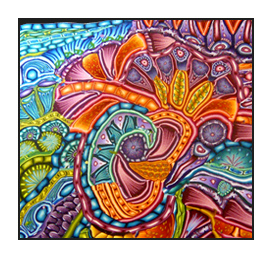
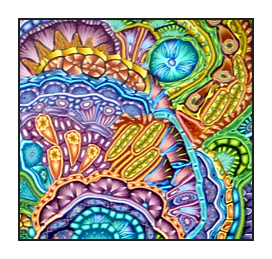

oh soooooo wonderful. Love the colors and the whole shebang.
That’s great! I’m thrilled to hear about buffs! Thanks for sharing esp. about the cement block, nuthing like modification for your own needs! Thanks. -Lyn
The mushroom buff is an interesting tool. Thanks for sharing. And, wow, the tidepool bowl is a piece of beautiful art.
I am wowed as usual by your work and designs. Thanx for sharing.
Carol – Thank you so much for sharing this! I also ran into this issue with a bowl I’d made using surface treatments – mainly Gilder’s pastes – and used a handheld oscillating buffer with unsatisfactory results. I’ll be on the hunt for the mushroom buff now, and a bench vise. Quick question: Did you use a variable speed drill?
Most importantly, your bowl is incredible!!
It was a variable speed drill on about the middle speed.
Could the fluffy buffer be used on a Foredom benchtop? Hmmmmmm. Something to investigate.
I wondered about that also.
Wow, thank you for posting about this, I never knew about mushroom buffers… I will have to get one. Your bowl is amazing, and so is the finish!
Thank you Beth!
Wow–so very cool, the difference. Mushroom buffs now on the list. Next time you need to break in a buff, try using the oldest coarsest file you have,not a rasp, just a big ol ‘bastard’ file; that’s what we used in the jewelry industry and it’s quick and effective. Be prepared for lots of fluff.
I love your bowl. It is beyond gorgeous. The buffing really made it but the art work is unbelievable. Fantasy work.